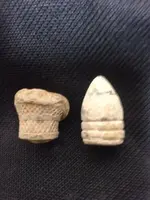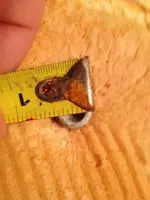Thank you very much for going to the extra efforts I requested to solve the mystery. Measuring the bullet at its "fat-est" part solves the mystery. It is a .54-caliber. The base is smaller due to corrosion on that part.
Ramming doesn't expand the bullet, but firing a Minie-ball does expand it.
Here's how I know it is a .54-caliber:
The ramrod mark on its nose and the rifling-marks on its body (visible in one of the photos) prove that it has been fired. Firing expands a Minie-ball's body outward into the gunbarrel's rifling-grooves. When you precisely measure your fired one, you are also measuring the thickness of the rifling-marks on its body. So, your fired .54-caliber minie's body expanded to fill the .54-caliber rifle's bore, and the rifling's depth is .05 -- which equals .545" total diameter after firing.
I agree, your guess about it being M&M-book bullet #425 (or another similar-profile .54 minie, like #424) is very probable, with xorrosion of its base having removed some of its weight. Also, mold-cast minies often contained internal air-bubbles, which reduces the minie's weight.
(Internal air-bubbles are what caused "blow-through" fired minies -- and that is why the yankees preferred to manufacture machine-pressed minies, like the so-called "swaged" minies.







